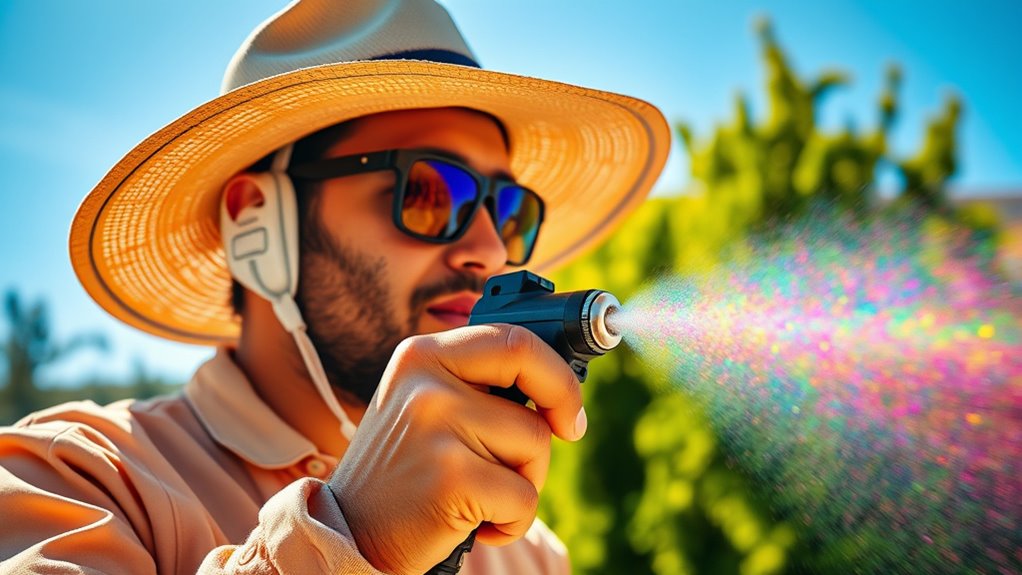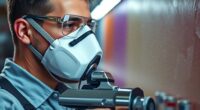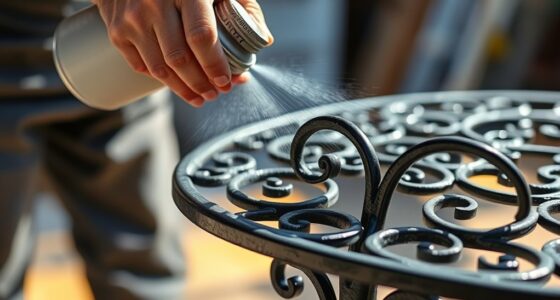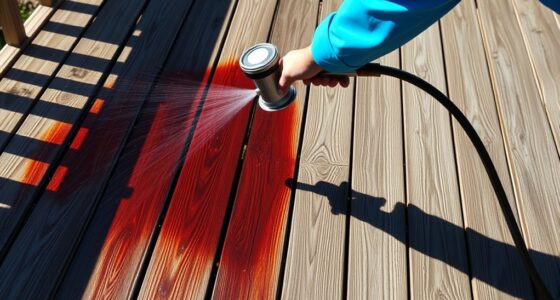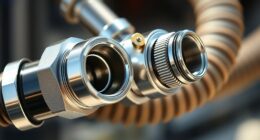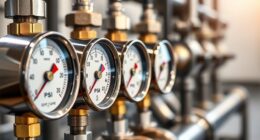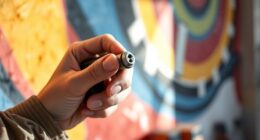To achieve great spray painting results in hot weather, start by working during cooler times like early morning or late afternoon, and create shade over your work area. Thin your paint slightly to improve flow and control spray application. Keep your spray gun steady, use light coats, and maintain a consistent distance from the surface. Proper surface prep and adjusting your technique can make all the difference—continue to explore these tips for ideal results.
Key Takeaways
- Schedule spray painting during cooler times like early morning or late afternoon to minimize heat impact.
- Create shade over the work area to reduce direct sunlight and slow paint drying.
- Thin paint slightly with recommended reducer to improve flow and prevent quick drying issues.
- Use light, multiple coats with steady, overlapping passes for a smooth, even finish.
- Properly prepare surfaces and apply primer to enhance adhesion and durability in hot conditions.
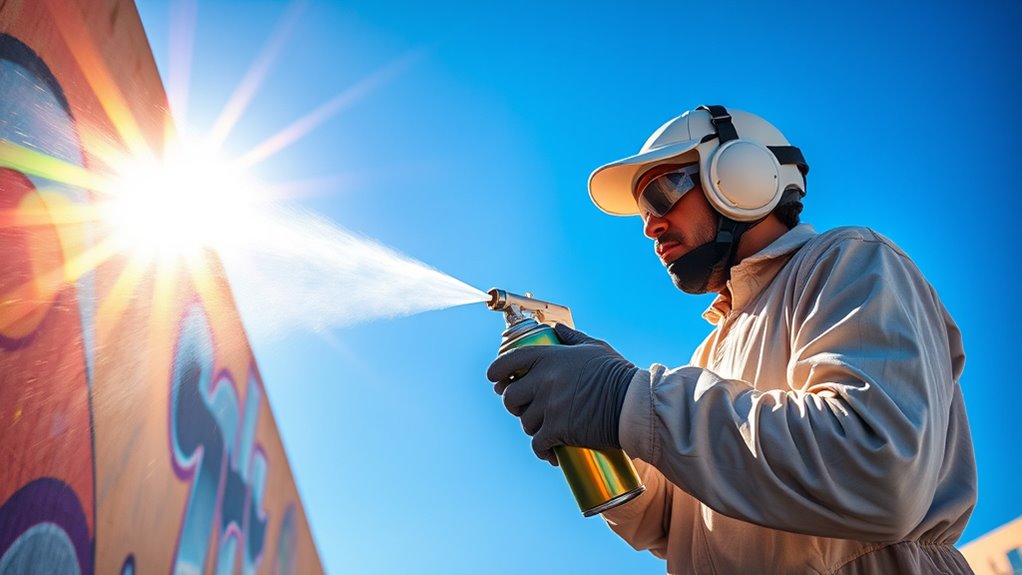
Spray painting in hot weather can be challenging because high temperatures affect how paint dries and adheres. When the sun beats down, the paint can dry too quickly, making it difficult to achieve a smooth, even finish. You might notice uneven color adhesion or streaks, which can ruin your project if you’re not careful. To combat this, you need to adapt your spray techniques to the conditions, ensuring you maintain control and precision.
One of the biggest issues with hot weather is the rapid evaporation of solvents in the paint. This quick drying can cause the paint to lift or crack if you’re not cautious. To improve color adhesion, you should start by thoroughly cleaning and prepping your surface. Remove any dust, grease, or old paint, and consider applying a suitable primer. A good primer helps the paint stick better and reduces the risk of peeling or flaking later. When you spray, keep your distance consistent—usually about 6 to 12 inches away from the surface—and use smooth, overlapping passes. This helps prevent runs and uneven coverage, which are common in hot conditions.
Rapid solvent evaporation in hot weather can cause paint lifting or cracking. Proper surface prep and consistent spraying help prevent issues.
Adjust your spray techniques by working during cooler parts of the day, such as early morning or late afternoon, when the temperature is lower. If you must paint during peak heat, try to create some shade over your project area. This reduces direct sunlight exposure and slows down the drying process just enough to give you better control. Also, keep your spray gun moving steadily; stopping mid-spray can cause uneven spots or drips. Use light, multiple coats instead of heavy layers, allowing each coat to dry just enough before applying the next. This approach helps maintain color integrity and adhesion, preventing issues like bubbling or cracking.
Another tip is to thin the paint slightly with an appropriate reducer or thinner recommended by the manufacturer. Thinning improves flow and reduces the chance of overspray or uneven application, especially in hot weather. Always test spray on a small area first to see how the paint behaves under the current conditions. If it dries too fast, try to slow it down with proper techniques or by adjusting your spray gun’s pressure. Additionally, understanding surface prep can significantly impact the durability and appearance of your finish in hot weather conditions.
Frequently Asked Questions
Can I Spray Paint in Direct Sunlight?
You might wonder if you can spray paint in direct sunlight. While it’s possible, it’s not ideal for spray paint safety or outdoor painting tips. Direct sunlight causes the paint to dry too quickly, leading to drips or an uneven finish. To get the best results, work in shaded areas or during cooler times of the day. This helps guarantee smooth application and durability, making your project look professional.
How Does Humidity Affect Spray Painting in Hot Weather?
Humidity impacts your spray painting process by increasing drying time, making it harder to achieve smooth, even coats. High humidity can cause paint to remain tacky longer, risking runs and imperfections. Conversely, low humidity speeds up drying, but may cause uneven coverage. You need to monitor humidity levels carefully, adjusting your technique accordingly, to guarantee consistent results and avoid issues like bubbling or poor adhesion.
What Types of Paint Are Best for Hot Conditions?
When choosing types of paint for hot conditions, opt for acrylic or latex paints, as they tend to have better paint durability and adhesion in high temperatures. These paints dry faster and resist cracking, ensuring a smooth finish. Avoid oil-based paints, which can bubble or peel in the heat. Selecting the right paint helps your project withstand the heat, maintaining its quality and longevity over time.
Is It Necessary to Wear Protective Gear in High Temperatures?
Think of protective gear as your shield in a battle; in hot weather, it’s essential for safety precautions. Wearing gloves, masks, and goggles guards you against harmful fumes and splatters, much like armor protecting a knight. You wouldn’t fight without protection, so don’t paint without it. Staying safe guarantees your project’s success, and your health remains intact amidst the heat. Always gear up for a safer, smoother painting experience.
How Do I Prevent Paint From Bubbling or Running in Heat?
To prevent paint from bubbling or running in heat, start with proper surface preparation by cleaning and sanding it thoroughly. Thinning your paint appropriately helps it flow smoothly, reducing drips. Apply thin, even coats and avoid painting during the hottest parts of the day. Keep the surface cool if possible, and allow each coat to dry fully before applying the next. These steps help guarantee a smooth, professional finish.
Conclusion
Now that you know the key tips for spray painting in hot weather, you’re almost ready to tackle your project. But remember, the true challenge isn’t just in applying the paint—it’s in knowing when to stop. If you push too hard or rush, the perfect finish could slip away. Stay patient, keep an eye on the conditions, and trust your skills. The best results come to those who master the balance between heat and patience—are you ready to find out how?
Franz came aboard the Paint Sprayer Zone team with a background in both journalism and home renovation. His articulate writing style, combined with a passion for DIY projects, makes him an invaluable asset. Franz has a knack for breaking down technical jargon into easy-to-understand content, ensuring that even the most novice of readers can grasp the complexities of paint sprayers.
